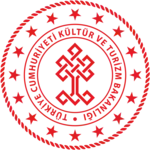Adana Archaeology Museum
Adana Archaeology Museum (Turkish: Adana Arkeoloji Müzesi) is a museum in Adana that houses the historical heritage of Cilicia. It is one of the oldest archaeological museums in Turkey.
Adana Arkeoloji Müzesi | |
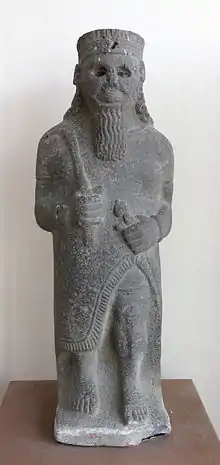 A statue from Tel Halaf at the Museum | |
 Location within Turkey | |
| Established | 1919 |
|---|---|
| Location | Döşeme Mahallesi Ahmet Cevdet Yağ Bulvarı, D:No:7, 01060 Seyhan, Adana, Turkey |
| Coordinates | 36.99489°N 35.31383°E |
| Type | Archeological |
| Area | 588,000 sq ft (54,600 m2) in 94 Galleries[1] |
History
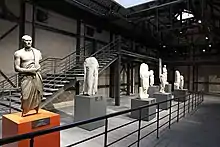

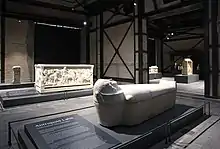




Adana Archaeology Museum is founded in 1919 during the French rule of Cilicia. The collection initially comprised diverse objects found by local civilians and French military personnel; an agreement with the Imperial Museum in Constantinople also allowed for the transfer of certain antiquities held in Silifke to the Adana museum.[2][3] After the formation of the Republic in 1924, Alyanakzade Halil Kamil Bey from Adana was appointed as the museum director and with his successful work, the accumulated material was moved in 1928 to the madrasah section of the no longer existing Cafer Pasha Mosque and then opened to the public.
The museum was moved to the building later occupied by the Ethnography Museum at Kuruköprü in 1950. Material from the early ages of Cilicia which was discovered during the excavations carried out at Tarsus/Gözlükule (1934), Mersin/Yumuktepe (1936), Ceyhan/Sirkeli (1938) and Yüreğir/Misis (1958) in particular, was collected at the museum. The museum eventually was filled to the brim with the ethnographic material collected by the museum director Ali Rıza Yalman (Yalkın) during the investigations he carried out between 1933–1940, and as it was the only museum of the region with material obtained either through purchases or court decisions from a large area reaching from Kahramanmaraş to Gaziantep, the museum moved again on January 7, 1972.
However, in the 2010s that location was gradually closing (it now houses an office for marriage registration), and a new, much larger complex was created some mile to the west, in the former production halls of a defunct textile industry. There it will become a neighbor to a City Museum, Museum of Agriculture, Museum of Industry, Museum of Ethnography, Children's Museum and Mosaic Museum, all planned to be opened in the coming years. The name on the front is "Adana Müzesi" and in 2019 the Archaeology part, including a large area with mosaics, mostly laid on the floor, was open. Many objects that formerly were in the gardens of the old museum are now protected from the elements inside, the space is huge, and will grow, as more of the old industry is being restored.
The museum
The museum has many objects from the Hittite period such as a statue of a god on a chariot, and many steles. But objects from earlier and later periods (Neolithic, Bronze Age, Iron Age, Archaic, Roman, Byzantine, Ottoman) abound also. Mainly Roman exhibited material include sarcophagi with rich garland decorations, jugs, catapult shots, inscriptions, altars and various architectural elements, glassware, ceramics and jewellery. Finds from specific excavations in the region are in a separate part. A marble sarcophagus depicting the Trojan wars in high relief is from Tarsus and is known as the Akhilleus sarcophagus. There is also a sarcophagus with a medusa from the antique city of Augusta which was submerged because of the Seyhan Dam Reservoir, and a human size bronze Karataş Statue from the Magarsus ancient city in Karataş, all of which are well known artefacts from the old museum.
The museum houses the only known inscription mentioning Apollonius of Tyana from 3–4th century CE [4]
The museum has, so far, grown in importance and size (an article mentions: some 12,500 square meters of a 68,400-square-meter venue), is much more spacious, has improved on the illumination and information and will, when the other museums are opened, warrant a visit of a full day (good facilities and a garden will make the stay comfortable). Though the Children's Museum seems not to have been realised, hundreds of children visit the museum daily, and enjoy - apart from the objects themselves - some fine dioramas of life in earlier times. Several video presentations provide information about a certain period, an introductory one shows great castles in the not too far distance as well as some local sights.
Gallery
 Adana Archaeological Museum Woman figurine Terra cotta Early Bronze Age
Adana Archaeological Museum Woman figurine Terra cotta Early Bronze Age Adana Archaeological Museum Hittite Masked Human figure
Adana Archaeological Museum Hittite Masked Human figure Adana Archaeological Museum Late Hittite Tarhunda on chariot
Adana Archaeological Museum Late Hittite Tarhunda on chariot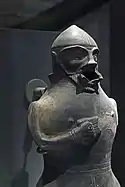 Adana Archaeological Museum Hittite Antropomorphic terra cotta jug
Adana Archaeological Museum Hittite Antropomorphic terra cotta jug
References
- Morgan, Hannah J. (29 January 2000). "Student Diary Travel Accounts". Archived from the original on 2011-05-27. Retrieved 2010-06-07.
- Shaw, Wendy. Possessors and Possessed: Museums, Archaeology, and the Visualization of History in the Late Ottoman Empire. pp. 213–214.
- Von Der Osten, Hans. Explorations in Hittite Asia Minor in 1929. p. 45.
In the afternoon we visited the small but important museum opened during the French occupation
- Jones, C. P. (1980). "An Epigram on Apollonius of Tyana". The Journal of Hellenic Studies. 100: 190–194. doi:10.2307/630745. JSTOR 630745.
External links
 Media related to Archaeological museum Adana at Wikimedia Commons
Media related to Archaeological museum Adana at Wikimedia Commons- Newspaper article of start in 2017
- Over 450 pictures of the old and new museum
